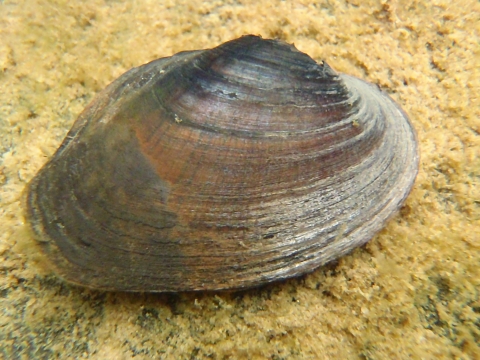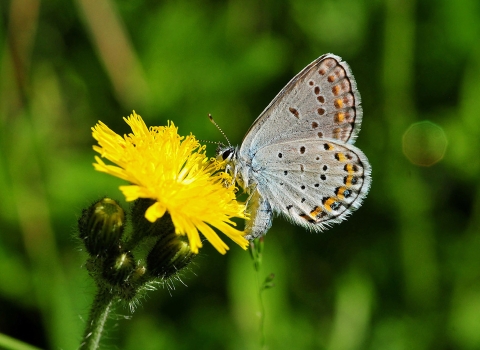If you could live a mostly sedentary lifestyle mud bathing in a riverbed all day, eating whenever you wanted to and cleaning the water in the process, would you?
This is a no-brainer for mussels in North America, which boasts the most diverse assemblage of freshwater mussels in the world.
One such mussel is the purple bean.
Though it acts as a natural filter for our waterways, it suffers from water pollution caused by chemical spills, accumulations of pollutants, and habitat destruction.
Thanks to a new round of funding under the Inflation Reduction Act of 2022, the purple bean can begin a journey towards recovery.
Meet the mussel
The purple bean (Villosa perpurpurea), also known as Tennessee bean, was listed as endangered under the Endangered Species Act in 1997. Adults are typically 1 to 3 inches long and can have either yellow or purple shell coatings. This species inhabits small creeks to medium-sized rivers and can be found in a variety of river bottoms.
Purple bean larvae require a parasitic stage, living on the body of a host fish while they mature into juveniles. When they reach a certain size, they detach and sink to the stream bottom, where they continue to develop. The purple bean occurs naturally in the upper Tennessee River drainage in Tennessee and Virginia and faces threats from impoundments, contaminants, toxic chemical spills and sedimentation.
Transforming tragedy into recovery
Jordan Richard has seen firsthand the trials and tribulations of the Service’s listed mussels. As species lead for the purple bean in our Southwest Virginia Ecological Services Field Office, he’s worked with the mussel for the past eight years. He joined the Service just in time to witness and research the unprecedented Clinch River die-off, which saw thousands of pheasantshell mussels perish unexpectedly in 2016. The fact that no other aquatic life was affected stumped biologists at the time. They concluded the mussels were experiencing disease caused by a pathogen similar to white-nose syndrome in bats and resolved to breed mussels in captivity to ensure their survival.
Our Freshwater Mollusk Conservation Center at Virginia Tech and the Aquatic Wildlife Conservation Center operated by the Virginia Department of Wildlife Resources have been successfully breeding and rearing purple bean and other mussels for reintroduction efforts in Virginia since 2002.
By attaching passive integrated transponder, or PIT, tags to the shells of mussels with dental cement, researchers can release hatchery-bred mussels into rivers known to be adequate for their survival and use scanners similar to metal detectors to identify them post-release.
In 2022, hundreds of captive-bred purple beans were released into the wild. This year, 60% of those mussels were rediscovered, proving the work done in hatcheries to breed mussels capable of surviving on their own is working.
With the mussels’ survivability under control, research turned to mussel pathogens to see if they might hold the key to solving the mystery of mussel die-off events.
Richard and his team devised a mussel health "check-up" that measured metrics like diversity of blood cells that support immune function, blood glucose levels, and reproductive capacity. They discovered that hatchery-bred mussels have a lower abundance and diversity of viruses than wild mussels. When released into the wild, both abundance and diversity increase dramatically. Research like this must continue to reveal more about the viruses threatening hatchery-born mussels and develop new techniques for reintroducing them to the wild.
Hero in a clamshell
Freshwater mussels — distinct from the farmed saltwater varieties served in restaurants — occupy the intersection of water and soil, making them invaluable to both aquatic and terrestrial ecosystems. In rivers, mussels link aquatic life forms. Healthy mussel populations generally indicate a healthy aquatic system, which often means good fishing and good water quality for waterfowl and other wildlife species. Mussels are natural filters, feeding on algae, plankton, and silts; they purify the aquatic system and keep drinking water clean.
As filter-feeders, mussels digest bacteria like E. coli and other contaminants — such as improperly flushed pharmaceuticals and herbicides in runoff — from the currents that bathe them. What mussels ingest, they break down, releasing some and storing the rest as nutrients in their soft tissue and shells. These nutrients include carbon, which mussels can store for the entirety of what is, at least for some species, century-long lifespans, making them at least small players in mitigating climate change climate change
Climate change includes both global warming driven by human-induced emissions of greenhouse gases and the resulting large-scale shifts in weather patterns. Though there have been previous periods of climatic change, since the mid-20th century humans have had an unprecedented impact on Earth's climate system and caused change on a global scale.
Learn more about climate change .
The cultural and historical significance of freshwater mussels lies in their use as food, ornamentations and tools by Indigenous peoples. Even in death, mussels are useful to the ecosystem, serving as food for otters, muskrats, ducks and other riverside residents.
Richard says mussel protection is the river version of replanting a forest. “People don’t directly feel the beneficial effects of mussels, but you will never see a healthy mussel population and nothing else.”
Made possible by...
On the second anniversary of the Inflation Reduction Act, the U.S. Fish and Wildlife Service announced a nearly $20 million investment in endangered species recovery implementation efforts, to supplement the $5 million received the year before.
The Service’s $25 million of the Inflation Reduction Act recovery implementation funds are reserved to support four focal species groups, one of which is freshwater mussels. Mussels targeted for species recovery efforts include Cumberland bean, southern combshell, Alabama lamp pearly mussel, Cumberlandian combshell, pale lilliput, Suwanee moccasinshell, Ochlockonee moccasinshell, and fat pocketbook.
The purple bean will receive $1.4 million towards its full recovery within the next 10 years. The funding will support a new specialist position that will focus primarily on purple bean recovery, as well as frequent health assessments for mussels to learn more about pathogens. Because they’re such useful ecosystem engineers, recovering mussels means ensuring the health of other water and land species as well.
Time will tell if purple bean recovery is successful. With such a long timespan between captive-breeding and sexual maturity in the wild, it may take five or six years to learn if purple beans can breed and survive without human interference. Deeper research into mussel health should lead to more certainty about breeding methods.
Tim Lane, southwest Virginia mussel recovery coordinator at the Aquatic Wildlife Conservation Center and one of the key players in purple bean captive breeding, has his own metrics of success for purple bean recovery.
“I want mussel biologists doing surveys to expect to find a purple bean instead of being excited and surprised. I hope otters and muskrats eat as much purple bean as they want. That’s how plentiful purple bean is meant to be.”











